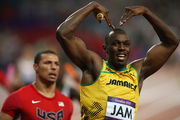
Imago
Credit: Instagram/Lindsey Vonn

Imago
Credit: Instagram/Lindsey Vonn
Sitting beside Winter Olympic sensation Eileen Gu, Lindsey Vonn wasn’t just offering advice this month in Madrid — she was offering proof. “A lot of women and girls are afraid to try because of the fear of failure, and I’ve fallen a million times and I’ve always gotten back up,” she said with the kind of conviction that only comes from having lived it.
Watch What’s Trending Now!
At this moment, Gu is the rising star — 21 years old, three Olympic medals from Beijing in her back pocket, and the future wide open. Vonn, by contrast, had last competed at the Winter Olympics in 2018. She left the sport the following year, not because she lost the will, but because her body — especially her battered right knee — could no longer keep up with her ambition. Years of high-speed crashes, torn ligaments, and over a dozen surgeries had taken their toll. In 2019, she announced her retirement, closing a chapter that many believed was her last. But not Lindsey.
Fast forward to March 2025. At age 40, after six years away and a staggering 2,565 days since her last podium, Vonn stood tall once again — quite literally — on the Alpine skiing World Cup podium. She had just become the oldest woman in history to do so, surpassing a record that stood at 34. Her smile was wide, not just from triumph, but from the joy of doing something she once feared she had lost forever.
ADVERTISEMENT
How did she get here? How did someone who retired with a knee so damaged it could barely support her through daily life suddenly become strong enough to compete — and win — again? The answer lies in a quiet transformation that started not with skis, but with surgery. In 2024, Lindsey Vonn underwent one final, high-risk knee replacement surgery. This time, she didn’t just repair — she rebuilt. A titanium knee replaced what had become bone-on-bone, and something extraordinary happened: the pain disappeared.
For the first time in years, Lindsey Vonn could train without pain. Her back, which had constantly overcompensated for the knee, stopped flaring up. Her hips stopped aching. She could sleep, move, train — and most importantly, dream — like an athlete again. “Now that my knee is good again, I don’t have any of the other problems,” she explained. “My back’s great. My body feels good. I feel better than I did in the last Olympics, by a lot actually.”
ADVERTISEMENT

ADVERTISEMENT
The comeback wasn’t just physical. It was deeply emotional — a journey that had as much to do with healing her heart as her knee. In interviews, Lindsey Vonn has alluded to struggles in her personal life that weighed heavily in the years after her retirement. But skiing, the thing that once hurt her the most, has once again become her source of strength. And where does this road lead? To Cortina, of course.
Cortina d’Ampezzo — the place where she first stood on a World Cup podium in 2004. The place where she broke Annemarie Moser-Pröll’s 35-year-old record in 2015. The place where she once dreamed of ending her career — but now hopes to begin her final, glorious chapter. “I’m going in looking to enjoy the experience,” Lindsey said recently. “Looking to be at a place that I love, that I’ve had a lot of success at.”
If she makes it to the 2026 Milano Cortina Winter Olympics, it will be exactly eight years since her last Olympic appearance — a bronze medal in Pyeongchang’s downhill event. But now, with a titanium knee and a spirit reborn, Lindsey Vonn has a chance to do what no one expected: to write a second chapter even more inspiring than her first. And that, perhaps, is what she meant when she said — with Eileen Gu sitting beside her — that she had always gotten back up. However, what remained different in her surgeries this time?
ADVERTISEMENT
Lindsey Vonn had some special treatment
“I’m a little bit older, but honestly, I’m a hell of a lot stronger than I once was.” That’s not just a motivational quote from Lindsey Vonn — it’s a warning shot from a legend rewriting the rules of athletic comebacks. Last December, Vonn surprised the world by finishing 14th in a super-G at St. Moritz — not just respectable for a retired athlete, but remarkable for someone who once believed her ski career was over for good.
ADVERTISEMENT

At 40, she wasn’t just racing. She was racing with a titanium knee. And now? She’s not just sharing her story — she’s pushing for a revolution in sports medicine. Back in April last year, Vonn underwent a robot-assisted knee replacement, the first of its kind for a World Cup skier. It was performed by Dr. Martin Roche, a leading orthopedist based in South Florida.
ADVERTISEMENT
The procedure was bold: surgeons cut off a portion of her battered right knee and replaced it with two titanium components, essentially giving her a bionic joint. Within weeks, Lindsey was already planning a return to the slopes. “It’s a lot better than my non-existent cartilage,” Vonn said with a smirk. “I’ve talked to a lot of skiers already about it, and I think it could be something that should be considered.” And it’s not just talk.
Top Stories
Bills Legend Jim Kelly Announces Final Cancer Update After Years of Battle

Calls Mount Against Refs’ Controversial Decision Involving Dak Prescott in Cowboys vs Lions TNF Game

Paris Olympics Snubs McDonald’s, but Usain Bolt Survived on 1,000 Chicken Nuggets During Beijing Games

Jared Goff Makes Bold Super Bowl Promise After Lions’ Win

Luka Doncic Inquired About Giannis Antetokounmpo Trade That Will Put 6 Lakers Stars At Risk – Reports

Robert Saleh Makes Final Decision on Head Coaching Job Away From Kyle Shanahan & 49ers

Vonn is already proving that this kind of surgery, once seen as a last resort for aging retirees, might be a game-changer for elite athletes with chronic knee injuries. The results speak for themselves: no more debilitating pain, no more swelling, no more limits. Just pure speed and strength. “I feel amazing,” the Olympic champion beamed. “Obviously, not everyone responds the same way to surgery. But for some reason, I bounce back pretty well.”
That’s an understatement. From career-ending pain to competing at a World Cup level again in less than a year, Vonn is blazing a trail few would dare follow. And in doing so, she’s opening up a new frontier — not just for her, but for an entire generation of athletes wondering if injury has to mean the end.
ADVERTISEMENT
ADVERTISEMENT
ADVERTISEMENT
ADVERTISEMENT

